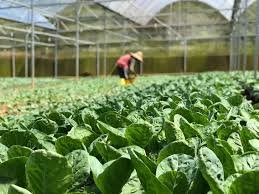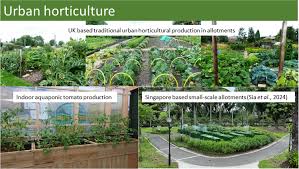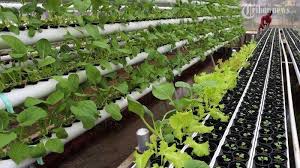In horticultural crop production, general agronomic practices are applied alongside specialized practices such as pruning, staking, and mulching on specific crops. These additional agronomic practices are carefully executed to avoid harming the crop.
Apart from agronomic practices, there are cropping systems employed in horticultural crops as well as field crops. This article explores various horticultural cropping systems.
Read Also: Vaccination Program for Poultry Chickens
Types of Horticultural Cropping Systems

A cropping system refers to the pattern or sequence in which crops are cultivated on a piece of land over a fixed period, along with their interaction with farm resources and other enterprises. In horticultural crop production, the following cropping systems are used:
1. Continuous Cropping
This is the practice of growing the same crop for two or more years on the same piece of land. Continuous cropping is typically employed when there are economic incentives for growing a single crop, or when there is a limited market for alternative crops.
This system allows for greater specialization in terms of management, equipment, and marketing. However, continuous cropping can lead to the exhaustion of nutrients, which must be replenished through organic means.
2. Crop Rotation
Crop rotation involves a planned sequence of different crops grown on the same land over multiple years. The rotation is designed to restore nutrients that are depleted over time and to diversify crop species. Key principles used in crop rotation include:
i. Deep-rooted crops should be followed by shallow-rooted crops.
ii. Crops likely to be affected by the same insect pests and diseases should not follow each other.
iii. Nitrogen-consuming crops should be followed by nitrogen-fixing crops.
iv. A short fallow period should be introduced into the rotation.
Read Also: Vaccination Program for Poultry Chickens
3. Sequential Cropping
Sequential cropping is the practice of growing crops continuously on the same land throughout the year. After harvesting one crop, another is immediately planted, either under rain-fed conditions or through irrigation.

This system keeps the land in use year-round, with the same or different types of crops. It requires continuous replenishment of nutrients removed from the soil, often through the application of fertilizers. This is typically done with crops in high demand throughout the year, such as vegetables. Sequential cropping includes:
i. Double Sequential Cropping: Growing two crops in sequence within a year.
ii. Triple Sequential Cropping: Growing three crops in sequence within a year.
iii. Quadruple Sequential Cropping: Growing four crops in sequence within a year.
iv. Ratoon Cropping: Cultivating crop regrowth after the first harvest for subsequent production.
4. Sole Cropping
Sole cropping involves growing one crop on a piece of land within a given farming season. This cropping system is common on large commercial farms, particularly in developed countries. Sole cropping is usually practiced for crops that are in high demand and offer high net returns to the farmer.
In Nigeria, the farm size for horticultural crops, especially vegetables, is smaller compared to other crops. Monoculture and mono-cropping are examples of sole cropping.
5. Intercropping
Intercropping is the practice of growing two or more crops on the same piece of land, either in rows or alternate arrangements. In intercropping, competition for resources occurs during all or part of the crop growth, and thus, it is essential to minimize this competition. To achieve this, the following factors must be considered:
i. Spatial Crop Arrangement: The planting pattern on the field.
ii. Plant Density: The number of plants per unit area.
iii. Maturity Dates: The timing of crop maturity.
iv. Plant Architecture: The canopy cover of the plants.
There are four types of intercropping based on spatial arrangement:
v. Row Intercropping: Growing two or more crops at the same time, with at least one crop planted in rows, alternating with the other crop.
vi. Mixed Intercropping: Growing two or more crops simultaneously without distinct row arrangements.
vii. Strip Cropping: Growing two or more crops together in strips, wide enough for separate crop production. The strips run perpendicular to the slope or prevailing wind direction to reduce erosion.
viii. Relay Intercropping: Planting two or more succeeding crops when the standing crop is at its reproductive stage but before harvesting.
6. Agro-Forestry
Agro-forestry is the practice of integrating tree cultivation into horticultural fruit tree plantations and arable farming through mixed cropping. It involves growing crops under the canopy of trees.
Agro-forestry sustains green cover year-round and integrates appropriate fertilizer trees into crop production. The system enhances nutrient supply through nitrogen fixation and nutrient recycling, while increasing the direct production of food crops, fodder, fiber, and income from tree products.
7. Alley Cropping
Alley cropping involves growing two or more crops in alleys formed by hedgerows of young tree crops or multipurpose trees and shrubs, preferably nitrogen-fixing leguminous species. This is a modified form of agro-forestry.
Cropping systems serve as a guide for farmers, helping them to plant crops efficiently, utilize environmental factors to their advantage, and sustain the ecosystem. It is vital for farmers to select and adopt cropping systems that offer significant benefits to all stakeholders in agriculture.
Do you have any questions, suggestions, or contributions? If so, please feel free to use the comment box below to share your thoughts. We also encourage you to kindly share this information with others who might benefit from it. Since we can’t reach everyone at once, we truly appreciate your help in spreading the word. Thank you so much for your support and for sharing!

